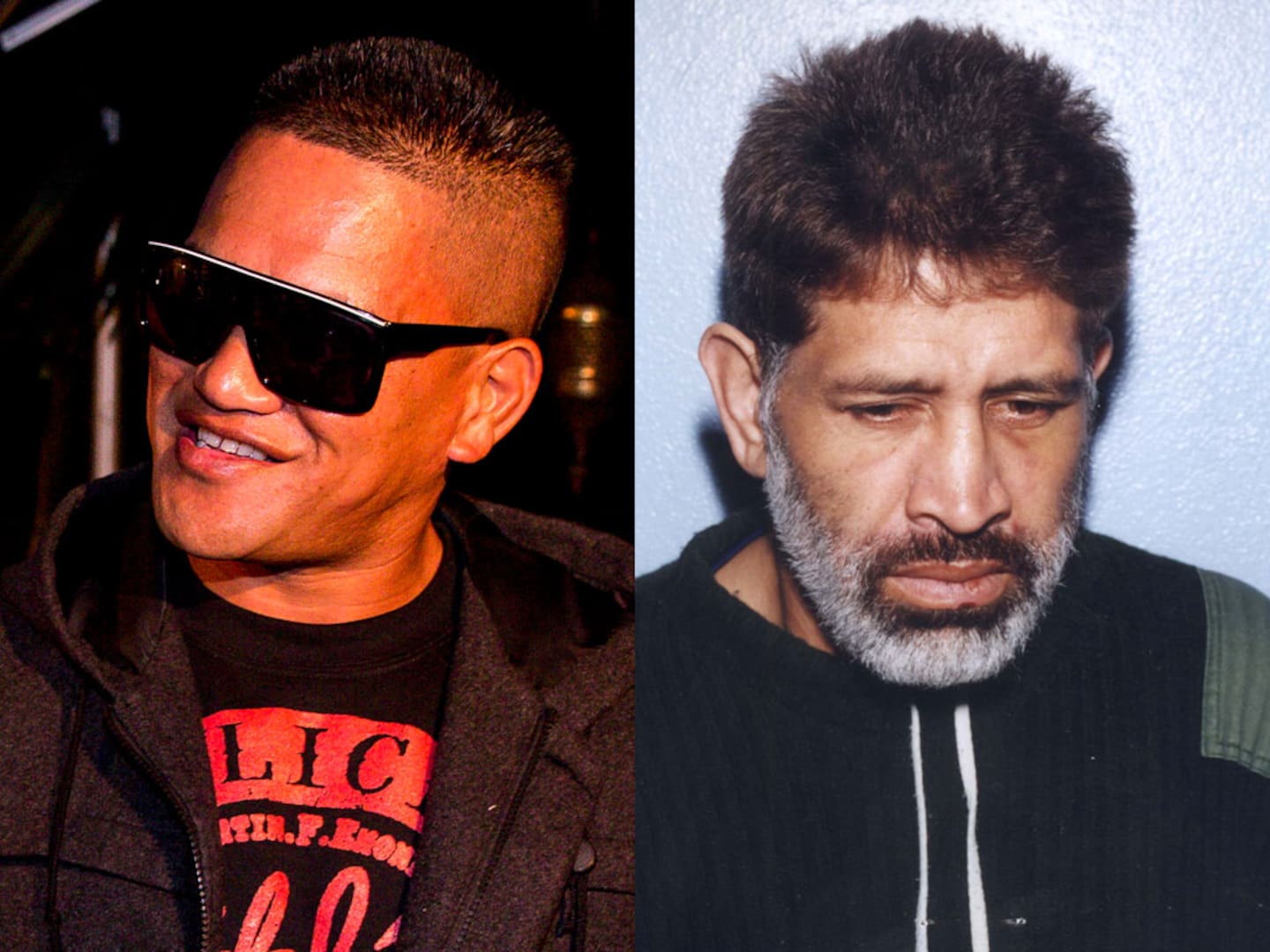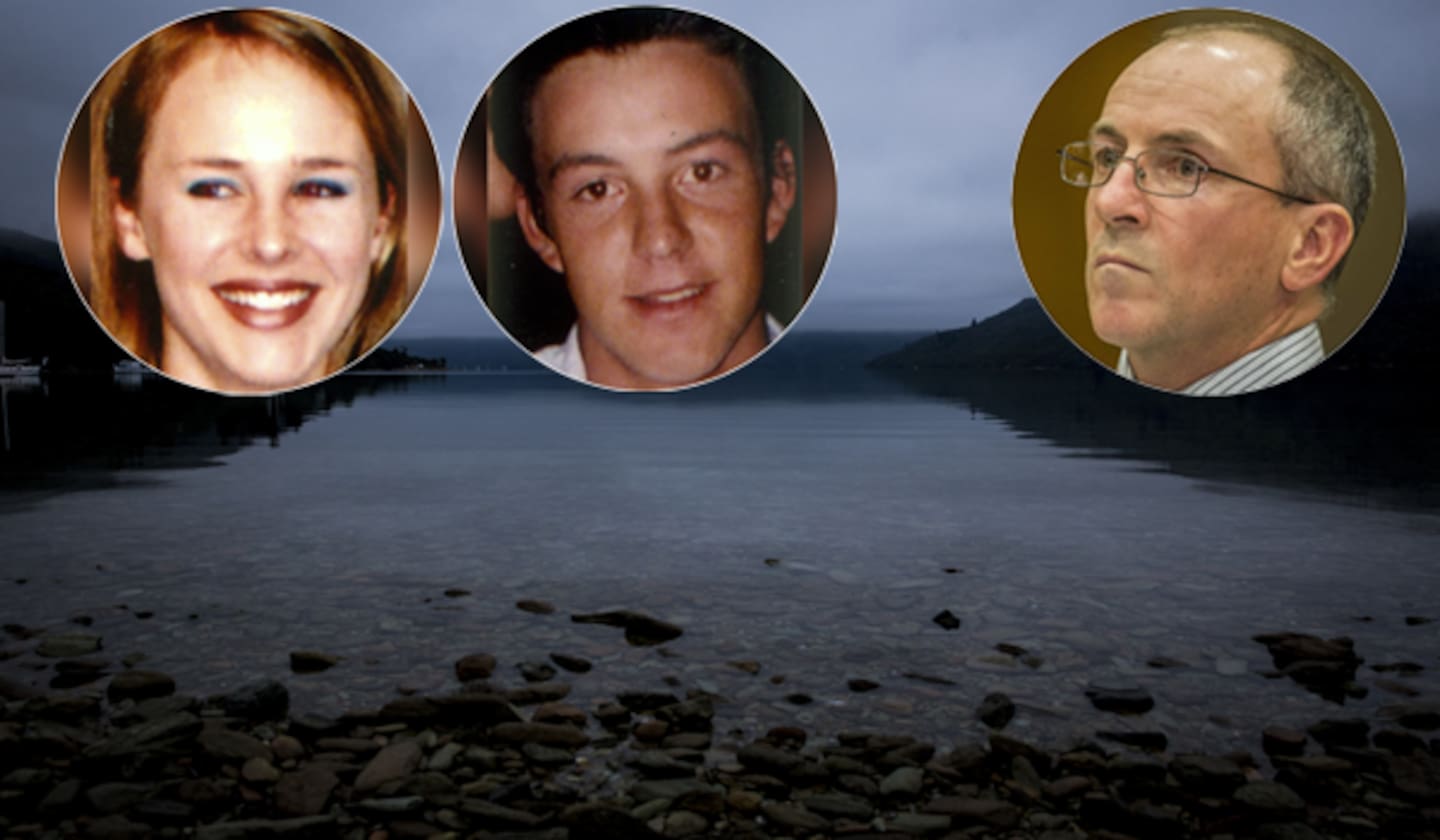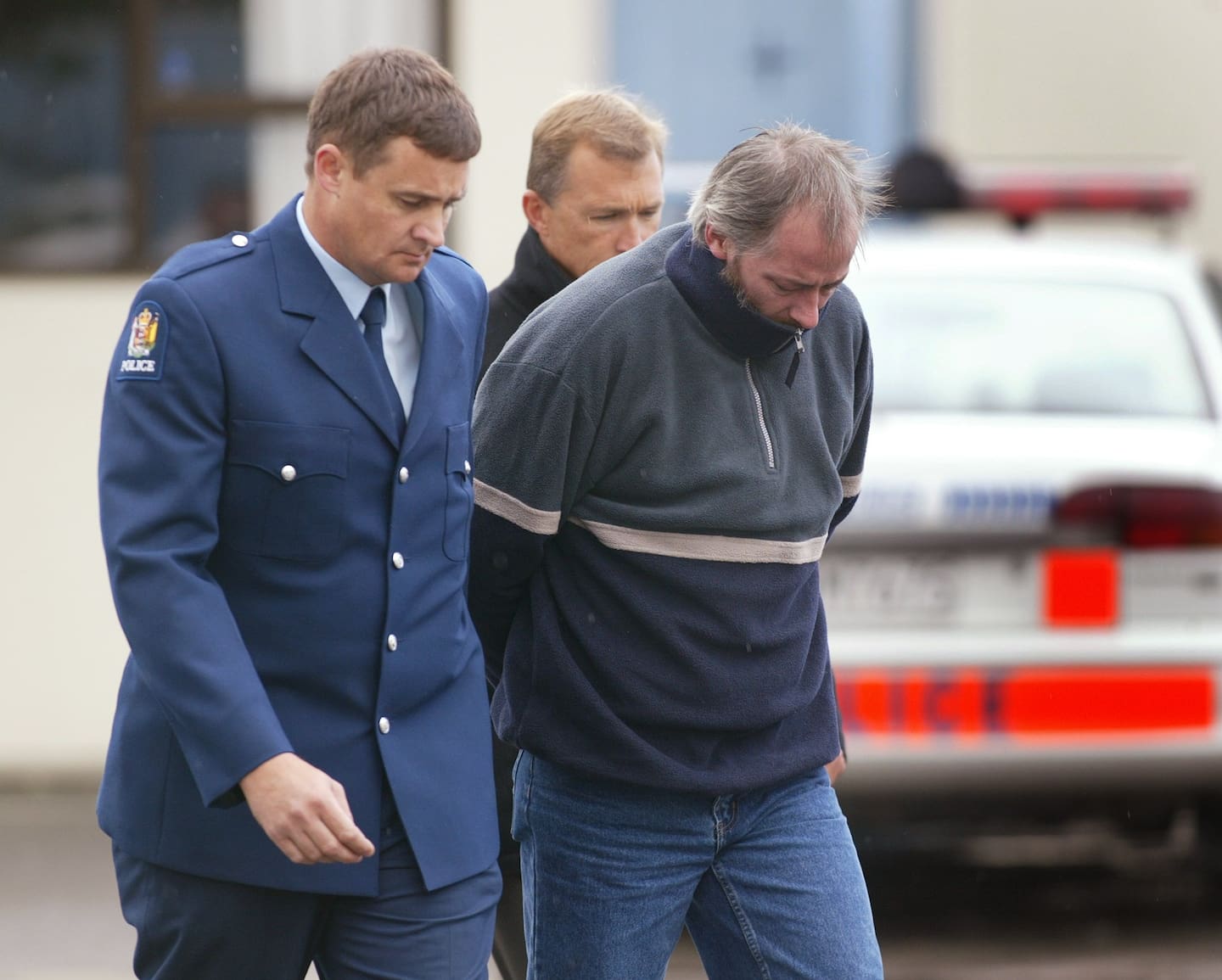There are 47 convicted murderers in New Zealand prisons who have served more than two decades of their life sentences without being granted parole.
Between them, they have killed 53 people – children, wives, family members, associates, strangers.
As well as being murderers, many are rapists, kidnappers, child abusers. All are violent and guilty of inflicting devastating and permanent damage to families and communities.
In New Zealand, a murder conviction comes with a life sentence and a minimum period of 10 years before parole can be considered.
Some of these prisoners’ crimes are so horrific that they are not yet eligible for parole – and won’t be for years.
Senior crime and justice reporter Anna Leask reveals who they are, their offending and victims, and how long they’ve been locked up.
 Peter Joseph Holdem in a photo taken on the day of his arrest for the murder of Louisa Damodran in 1986. Photo / Supplied
Peter Joseph Holdem in a photo taken on the day of his arrest for the murder of Louisa Damodran in 1986. Photo / Supplied
Peter Holdem: July 1987
Child murderer Peter Joseph Holdem has spent 37 years in prison, repeatedly rejected by the Parole Board because he remains a danger to the public.
He is considered at high risk of further sexual offending and it’s said he has made little progress in prison, showing “little empathy” for the victims of his horrendous offending.
Holdem was jailed for life in 1987 for the murder of 6-year-old Louisa Damodran near Christchurch.
Louisa was days shy of her 7th birthday when Holdem kidnapped her as she walked home from school in October 1986.
She was just 100m from home when Holdem, who already had an extensive and bleak criminal record, swiped her off the street and drove her to the Waimakariri River north of the city.
There, he throttled Louisa and drowned her. Her body was found downstream three weeks later.
At the time of the murder, Holdem was on parole after being convicted of the attempted rape of a 10-year-old in a Christchurch park in 1982.
He had a history of sex attacks on children dating back to the 1970s.
Holdem became eligible for parole in 1996.
In 2023, he told his case manager he did not think he needed any further treatment, that he wanted to reintegrate “now” and felt he had done enough in prison to warrant that.
 Louisa Bina Damodran was kidnapped, molested and murdered by a prolific recidivist child sex offender in 1986. More than 35 years later he has apologised.
Louisa Bina Damodran was kidnapped, molested and murdered by a prolific recidivist child sex offender in 1986. More than 35 years later he has apologised.
However, the board said he remained an undue risk.
“He has little real empathy with the victims and has significant memory limitation. He is assessed as being high risk of sexual reoffending and medium risk of violence. Really, since our last contact with Mr Holdem, no real progress had been made,” said Parole Board chairman Sir Ron Young last year.
Louisa’s mother, Aynsley Harwood, has previously spoken to the Herald about her harrowing parole journey.
She makes a submission to the board every time Holdem is due to appear. She feels obliged to do what she can to keep him locked up, fearing he will kill again.
“As Louisa’s mother, it’s my job to defend her and make sure no other child goes through what she went through,” she said.
“There is a lot of anxiety but I push myself to do it ... It’s miserable ... I started to feel guilty over him being kept in prison.
“It’s all a bit dismal. I’m just stressed all the time, preparing myself in case he gets out ... wondering if I am doing the right thing keeping him in there.”
Department of Corrections records released to the Herald under the Official Information Act show there is only one convicted murderer who has served longer in prison than Holdem without being granted parole.
Gary Lawrence McKinley was jailed in June 1987 for the fatal attack on 23-year-old Wendy Snowdon while she was out jogging in a New Plymouth park in November 1986.
McKinley knocked her unconscious with a rock, carried her to a remote track and sexually assaulted and throttled her.
Soon afterwards, a person walking their dog found Wendy, who’d been left for dead. She was taken to hospital and died 16 days later.
 Gary McKinley appearing in the Wellington District Court after he was charged with attacking a prison guard. Photo / NZPA
Gary McKinley appearing in the Wellington District Court after he was charged with attacking a prison guard. Photo / NZPA
Paul Dally: August 1990
Dally kidnapped Karla Cardno, 13, as she rode her bike home from the shops in Lower Hutt. He repeatedly raped and tortured her for 22 hours, before beating her and burying her alive in a shallow grave.
 Karla Cardno, 13, was murdered by Paul Dally in 1989.
Karla Cardno, 13, was murdered by Paul Dally in 1989.
Paul Bailey: February 1992
Kylie Smith, 15, was riding her horse in Owaka, South Otago, when Bailey – on bail for a rape charge – approached her with a gun, forced her into his car then drove into an area of bush. He sexually assaulted and murdered her.
 Raymond Ratima was sentenced to life imprisonment in 1993 after pleading guilty to seven counts of murder, attempted murder and killing an unborn child. Photo / NZ Herald
Raymond Ratima was sentenced to life imprisonment in 1993 after pleading guilty to seven counts of murder, attempted murder and killing an unborn child. Photo / NZ Herald
Raymond Ratima: September 1992
Ratima murdered sons Piripi, 7, Barney, 5, and Stacey, 2, along with his brother-in-law Philip Ferguson jnr, 14, his heavily pregnant sister-in-law Nicola Ferguson, 20, her partner Bevan Tepu, 21, and their son Stephen, 3.
Stephen Williams: February 1993
Siale Fotu: September 1994
Then a teen, Fotu murdered businessman Jim Fletcher during a botched burglary at his Pāpāmoa beach house on New Year’s Eve.
James Tamata: July 1995
Janine Law’s death at her Auckland home was initially ruled the result of an asthma attack. However, seven years later Tamata admitted raping and murdering her.
Richard Genge: October 1995
Genge and two others raped and murdered 22-year-old Anne Maree Ellens at a Christchurch school.
 Phillip John Smith has been unsuccessful in his application for a judicial review to have a rule banning child sex offenders in prison from having sex. Photo / Nick Reed
Phillip John Smith has been unsuccessful in his application for a judicial review to have a rule banning child sex offenders in prison from having sex. Photo / Nick Reed
Phillip Smith: April 1996
Smith fatally stabbed the father of a young boy he had been sexually assaulting for three years. While preparing for possible parole, Smith was permitted temporary release from prison and managed to flee to South America before he was tracked down.
Darryl Leonard: October 1996
Leonard murdered Christchurch woman Marilyn Thomson.
Samuela Nikoro: March 1997
Nikoro was 16 when he stabbed Vincent Grant, a 15-year-old from Aranui, Christchurch.
Joseph Walker: March 1997
Walker murdered Thomas McLean in Panmure.
Christopher Foster: April 1997
 William Dwane Bell at the High Court in Auckland before he was sentenced to a minimum non-parole period of 33 years (reduced to 30 years on appeal) for the RSA murders. Photo / NZME
William Dwane Bell at the High Court in Auckland before he was sentenced to a minimum non-parole period of 33 years (reduced to 30 years on appeal) for the RSA murders. Photo / NZME
William Bell: 2003 for three murders.
Bell murdered Mary Hobson, 44, Wayne Johnson, 56, and William Absolum, 63, and badly injured Susan Couch during a robbery at the Mt Wellington-Panmure RSA in December 2001.
He was on parole at the time of the murders and already had 102 convictions. He is not eligible for parole until 2030.
Richard Tuhoro: September 1997
Glen Payne, 23, was working as a bottle store attendant when he was shot dead by Tuhoro during an armed holdup at the Caledonian Hotel in Christchurch.
Andrew Luatua: October 1997
Luatua murdered Isaac Herbert outside his Glen Innes flat.
Mani Seu: November 1997.
John Edmonds: November 1997
Edmonds murdered his 12-year-old daughter Peti Kokiri in Gisborne.
Gareth Smither: December 1997
Smither stabbed his ex-girlfriend Karen Jacobs using knives and a garden spade while her toddler was in the next room at their Dunedin home.
 Gareth Lawrence Smither killed Karen Rachel Jacobs (pictured). Photo / Supplied
Gareth Lawrence Smither killed Karen Rachel Jacobs (pictured). Photo / Supplied
Michael Manihera: February 1998
Manihera killed bottle store manager Ian Comrie in Whanganui.
Tippie King-Hazel: February 1998
Lon Reti: July 1998
Reti murdered Leslie Edmonds in Christchurch.
Malcolm Rewa: July 1998
Rewa was jailed for a spate of sex attacks and was later found guilty of murdering Susan Burdett after three high-profile trials. He is not eligible for parole until 2027.
 Teina Pora (left) was initially convicted of murdering Susan Burdett but was cleared by the Privy Council. That opened the way for more legal action against Malcolm Rewa. Photo / NZ Herald
Teina Pora (left) was initially convicted of murdering Susan Burdett but was cleared by the Privy Council. That opened the way for more legal action against Malcolm Rewa. Photo / NZ Herald
John La Roche: December 1998
La Roche stabbed his former partner and mother of his children Margaret Bennellick in a room at the Palmerston North District Court while waiting for a custody hearing.
Stephen Stone: March 1999
Stone was convicted of murdering Deane Fuller-Sandys and Leah Stephens.
The Court of Appeal has confirmed a six-day hearing into Stone’s case will be held in August 2024.
Terry Nahi: May 1999
Lisa Hurrell, 21, was killed by Nahi in her Christchurch home. The pair had been in a troubled relationship since Hurrell was 14 and they had three children together. She had a protection order against him at the time.
Graeme Colquhoun: June 1999
Gavin Dacombe: July 1999
 Olivia Hope, Ben Smart and Scott Watson. Photos / File / NZME
Olivia Hope, Ben Smart and Scott Watson. Photos / File / NZME
Scott Watson: September 1999
Watson was convicted of murdering Ben Smart and Olivia Hope on New Year’s Eve in the Marlborough Sounds.
Watson has always denied the offending and has been granted an appeal to be heard later this year.
Johnny Manu: September 1999
Manu, diagnosed with schizophrenia, fatally stabbed ACC staffer Janet Pike after he became agitated during a visit to her office in Henderson, West Auckland.
He had 14 earlier convictions for violence, including stabbing a bank worker.
Sonny-Boy Makoare: October 1999
Makoare was 15 when he stabbed his 17-year-old friend Rashley Walker to death in Otara.
Ian Johnson: December 1999
Johnson murdered his flatmate Stavros Stavrianos, 49, in the toilet at their Green Bay house. A piece of skull peppered with shotgun pellet marks was the only part of his body that police found.
James Wilson: February 2000
Wilson, known as “Little Willy”, was president of the Filthy Few motorcycle gang when he murdered his former girlfriend Jo-Anne Van Duyvenbooden in Tauranga.
Edwin Whiu: September 2000
Whiu fatally stabbed James Edward Wilson at a Manurewa lodging house. Wilson and Whiu’s girlfriend had argued, angering him. Whiu later found Wilson in a lounge, punched him in the chest, verbally abused him and stabbed him twice in the back.
Jamie Howard: February 2001
Howard is convicted of murdering Robert Harman, whose battered and burnt body was found at Godley Head in the Port Hills in Christchurch.
Nikora Turner: August 2001
Turner murdered 42-year-old Taumarunui mother Te Miringa Tipene, also known as Milly Dunn. He beat her to death and left her to decompose in the house for six days before she was found by her daughter on a social call.
Ratima Osborne: November 2001
Osborne was driving back from carrying out a home invasion when he picked up hitchhiker Jason Napier. The then-18-year-old beat Napier over the head with a wooden baton and then ran him over. When he cropped up as a murder suspect, he was already in custody for the aggravated robbery.
Dion McQueen: November 2001
McQueen cut Paropkari Lal’s throat from ear to ear and castrated him. He pleaded not guilty on the grounds of insanity but was found guilty of murder.
 The Lundy family about 18 months before the double murder. Photo / Supplied
The Lundy family about 18 months before the double murder. Photo / Supplied
Mark Lundy: March 2002
Lundy has been convicted at two separate trials of hacking his wife Christine and their 7-year-old daughter Amber to death at their Palmerston North home, likely with an axe or tomahawk, in 2000. [Lundy did spend time out of prison on bail as he awaited his retrial.]
Peter Carrington: June 2002
Carrington murdered Mya Sollis, 73, on a West Coast beach. An autopsy found she died of blood loss from 11 stab wounds to the neck and face, including her eyelids.
Ese Falealii: July 2002
Falealii murdered Marcus Doig, a 23-year-old Howick man who was working at a pizza shop. A week later he murdered Mangere Bridge bank teller John Vaughan, 44. Both victims had obeyed demands to lie on the floor – and were shot with the same gun in the back of their heads.
At the time Falealii’s was given the second-longest non-parole period for murder handed out in this country.
Ricky Frew: September 2002
Frew murdered Christine Bailey in Nelson. He had been in a relationship with the mother of two for 18 months. She had sought help from the police, Women’s Refuge and other agencies to help escape his abuse.
Eneasi Finau: November 2002
Finau was one of three Tongan Crips gang members who killed a rival Samoan Bloods gang member in prison. Tue Faavae, 23, was an inmate at Auckland prison when Finau’s gang boss ordered the execution.
 Double murderer Bruce Howse is escorted by police officers into the Masterton District Court in 2002. Photo / Mark Mitchell
Double murderer Bruce Howse is escorted by police officers into the Masterton District Court in 2002. Photo / Mark Mitchell
Bruce Howse: December 2002
Howse murdered his stepdaughters Olympia Jetson and Saliel Aplin as they lay in their beds at their Masterton home. The girls, aged 11 and 12, had suffered years of physical and sexual abuse at the hands of Howse and, despite their cries for help, it never came.
Stephen Hudson: February 2003
In 2002, Nicholas Pike was led to a remote location in the central North Island and killed by Stephen Hudson. Pike’s body has never been found. Hudson is eligible for parole in 2026.
Darran Mackness: March 2003
The Hamilton man kicked his 12-year-old stepdaughter Kelly Gush to death. When admitted to hospital, Kelly weighed just 26kg and had spent most of her time at home locked in her bedroom with the door locked from the outside windows nailed shut.
The list of killers provided by Corrections under the OIA had three names redacted. These names were either permanently suppressed by the courts, or suppression details could not be ascertained.
Does a life sentence actually mean life in New Zealand?
Since the death penalty was abolished in 1989, having not been used since 1957, a life sentence became the most severe form of punishment for criminal offending.
Life does actually mean life in New Zealand. A person ordered to serve life has that sentence over them until the day they die.
Offenders sentenced to life imprisonment must serve a minimum of 10 years in jail before they are eligible for parole.
A sentencing judge can, and usually does, set a longer minimum non-parole period depending on the brutality, severity and impact of the offending.
When an offender becomes eligible for parole they must appear before the board and prove they do not pose an undue risk to the safety of the community.
The Parole Board is under no obligation to release them just because they are eligible. It must be 100 per cent satisfied all risks and chances of reoffending have been mitigated as far as possible.
 Parole Board chair Sir Ron Young. Photo / Aaron Smale, IKON Media, File
Parole Board chair Sir Ron Young. Photo / Aaron Smale, IKON Media, File
It is rare for an offender to be granted parole at their first hearing.
Even if a convicted murderer is released, their life sentence stands. While they are allowed to live in the community, they are subject to permanent conditions and often special conditions specific to their offending.
If they breach those conditions or commit a new offence, they can be recalled to prison to continue serving their life sentence. When that happens, their parole process begins again and they have to convince the board they can be trusted outside the wire.
The longest non-parole period in New Zealand was handed down to triple murderer William Bell.
Judges also have the option to jail someone for life without parole. That mechanism of the law has been used only once in New Zealand, for Christchurch terrorist Brenton Tarrant.
Anna Leask is a Christchurch-based reporter who covers national crime and justice. She joined the Herald in 2008 and has worked as a journalist for 18 years. She writes, hosts and produces the award-winning podcast A Moment In Crime, released monthly on nzherald.co.nz.
This article was originally published on the NZ Herald here.
Take your Radio, Podcasts and Music with you









